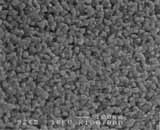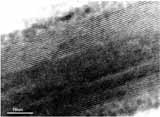ELECTROCHEMICAL CAPACITORS (SUPERCAPACITORS, ULTRACAPACITORS)
An electrochemical supercapacitor, also known as supercapacitor or ultracapacitor,
is an energy storage device that can charge/discharge at extremely high
speed (much faster than conventional batteries) with high capacity (much
higher than conventional capacitors) and can be recharged almost eternally
(over 10,000 times). Such devices find use in environmentally bengin transportation
such as hybrid vehicles, EV and HEV, as well as portable devices such as
PDA, notebook computers, cell phones, and much more. Present R&D is
concentrated on the improvement in the energy and power density (how much
and how fast the device can store energy) of the device. We are presently
developing new electrode materials based on oxides that can fullfill the
requirements of the next generation power sources.
Click here for more details (coming soon). |
Nanoparticulate Oxides
Electrochemical supercapacitors using oxide electrodes with aqueous electrolytes
(often called pseudocapacitors or redox capacitors) are capable of providing
high capacitance (2-10 times higher than carbon electrodes) at high rate.
Naturally, the development of advanced oxide electrodes is one of the key
technologies that must be achieved. It is necessary to improve the activity
and increase the cost-performance of the oxide electrodes for commercialization
fo such devices. Approaches to accomplish this is to synthesize nanoparticles,
especially hydrous nanoparticles) or binary oxides. We are presently working
to find new highly active oxide electrodes and functional 'value-added'
supercapacitors. |

A typical high resolution FE-SEM image of 10 nm RuO2 nanoparticles. |
|
|
Nanostructured Ruthenium Oxides (Layered Ruthenium Oxide, Ruthenium Oxide
Nansheets)
Ruthenium oxide is presently the best material for pseudocapacitors in
terms of the energy and power density. However, due to the scarcity and
cost of precious metals, it is essential the the active surface area of
the material is increased and that the usage of the precious metal is decreased.
This can be achived by nanostructured design of oxides, for example layered
oxides and oxide nanosheets. By using a layered oxide, one can use the
interlayer of the bulk material for charge storage, leading to an increase
in the active surface area. Another method is to prepare nanosheets, which
in a sense can be taken as a ulitamate case of two-dimensional nanostructure.
We are presently engaded in the fundamental study of the supercapacitve
behavior of oxide electrodes, preparation of novel nanostructured oxides,
and the development of functional 'value-added' supercapacitors.
|

A typical high resolution TEM image of a layered ruthenium oxide. |
|